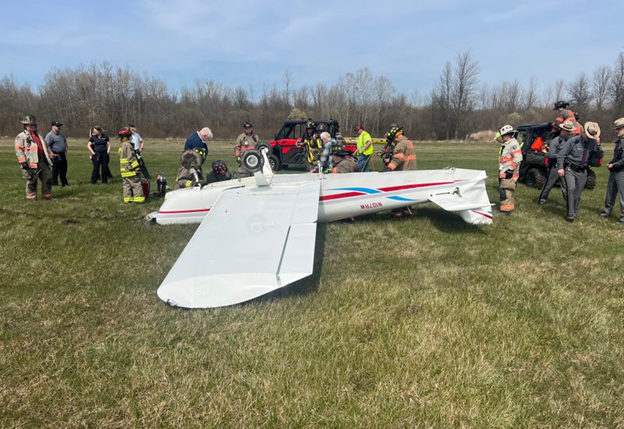ARFF Daily News
Published on:
Thursday the 11th of April, 2024
New York State Police investigating small plane crash in East Amherst on Wednesday
The 82-year-old pilot was transported to ECMC for minor injuries
By WBEN.com Newsroom
East Amherst, N.Y. (WBEN) - New York State Police is looking into the cause of a small plane crash on Wednesday in East Amherst.
Troopers out of SP Clarence responded to Clarence Aerodrome Airport on Transit Road for a reported plane collision. An immediate investigation determined that the single engine plane was attempting to take off, and the front tire of the small plane sank in the mud, causing the plane to flip upside down.
Responding troopers and emergency crews assisted in getting the 82-year-old pilot out of the plane. The pilot was transported to Erie County Medical Center for minor injuries.
State police say this continues to be an ongoing investigation.
https://www.audacy.com/wben/news/local/new-york-state-police-investigating-small-plane-crash-in-east-amherst-on-wednesday

NTSB Final Report: Cessna P210N
He Heard Another Pilot Report That He Was Landing At The Airport And Would Cut In Front Of Him
Location: Olivehurst, California Accident Number: WPR23LA234
Date & Time: June 9, 2023, 20:55 Local Registration: N4761A
Aircraft: Cessna P210N Aircraft Damage: Substantial
Defining Event: Landing gear not configured Injuries: 1 None
Flight Conducted Under: Part 91: General aviation - Personal
Analysis: The pilot reported that while on a straight in approach to land, he heard another pilot report that he was landing at the airport and would cut in front of him. The accident pilot discontinued the approach and performed a 360° turn.
He then resumed the approach and continued to land but failed to extend the landing gear. The airplane sustained substantial damaged the left and right keel beams.
The pilot reported that there were no mechanical malfunctions or failures that would have precluded normal operations.
Probable Cause and Findings: The National Transportation Safety Board determines the probable cause(s) of this accident to be -- The pilot’s failure to extend the landing gear before landing.
FMI: www.ntsb.gov

Today in History
72 Years ago today: On 11 April 1952 a PanAm Douglas DC-4 crashed into the sea after takeoff from San Juan, killing 52 out of 69 occupants.
Date: Friday 11 April 1952
Time: 12:20
Type: Douglas DC-4
Owner/operator: Pan American World Airways (Pan Am)
Registration: N88899
MSN: 10503
Year of manufacture: 1945
Total airframe hrs: 20835 hours
Engine model: Pratt & Whitney R-2000
Fatalities: Fatalities: 52 / Occupants: 69
Aircraft damage: Destroyed, written off
Category: Accident
Location: 18 km NW off San Juan-Isla Grande Airport (SIG) - Puerto Rico
Phase: En route
Nature: Passenger - Scheduled
Departure airport: San Juan-Isla Grande Airport (SIG/TJIG)
Destination airport: New York-Idlewild International Airport, NY (IDL/KIDL)
Investigating agency: CAB
Confidence Rating: Accident investigation report completed and information captured
Narrative:
The aircraft, named "Clipper Endeavour" took off from San Juan at 12:11 for a flight to New York when the no. 3 engine failed. The prop was feathered at 350 feet and the crew elected to return to San Juan. The aircraft reached an altitude of 550 feet but the no. 4 engine ran roughly and height couldn't be maintained. To avoid a possible forced landing in a congested area or on coral reef, the aircraft was ditched 11 miles NW of San Juan Airport, 4,5 miles offshore. The rear fuselage broke off behind the bulkhead aft of the main cabin. The plane sank in about 3 minutes.
PROBABLE CAUSE: "a) The company's inadequate maintenance in not changing the No. 3 engine which resulted in its failure immediately subsequent to take-off, and b) The persistent action of the captain in attempting to re-establish a climb, without using all available power, following the critical loss of power to another engine. This resulted in a nose-high attitude, progressive loss of airspeed and the settling of the aircraft at too low an altitude to effect recovery,"

Mailing Address
Subscribe to our newsletter
Contact Us
We will get back to you as soon as possible.
Please try again later.
